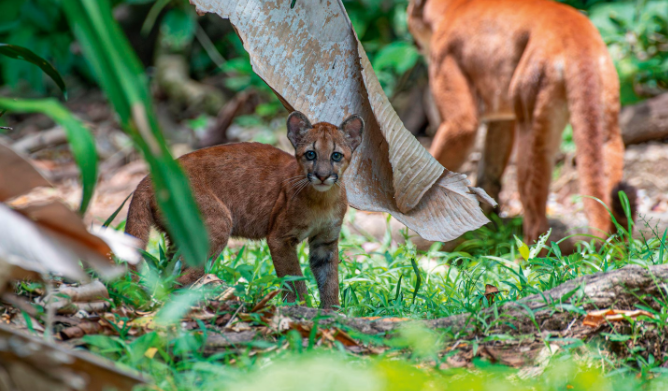
I never thought I’d find myself playing grandmother’s footsteps with a puma. After a morning fruitlessly searching the trails surrounding SCP Corcovado Wilderness Lodge for big cats, we’ve returned to the lodge where head guide Mario Chavarria Fuentes has dropped a bombshell — a male puma was just seen outside guest villa number seven.
“It could still be here,” he reassures me, gesturing towards the rainforest surrounding the open lawns of the guest cabins. Walking back to mine — a puma-deficient number 11 — it’s difficult to shake off the feeling that if I turn around, I’ll come face-to-face with one of the world’s most elusive felines. It’s both exhilarating and terrifying in equal measure. It’s hard not to feel like you’re being watched when you’re in Costa Rica’s Osa Peninsula, whether by a puma or some other creature. The place is home to the world’s highest concentration of flora and fauna and some 2.5% of the world’s biodiversity — all in an area roughly the size of the Isle of Man. For unclear reasons, it continues to hover beneath many visitors’ radars, despite acting as a stronghold for half of Costa Rica’s animal and plant species, including one of the last tracts of untouched tropical lowland rainforest.

The wildlife seems keen to be observed, too. Just outside my bedroom, a band of raccoon-like coatimundi mill around a palm, occasionally tumbling to the ground like drunk gymnasts, while high above, there’s a swallow-tailed kite, its white wings catching in the sun as it circles. A family of jaguars live nearby, while a bunch of Baird’s tapirs regularly ramble around the staff football pitch.
Recently, a guide encountered an incredibly rare harpy eagle. Over a single night, a trail camera has captured videos of an ocelot, a puma and a jaguar passing through the lodge’s 188 acres of primary rainforest. It sounds like the start of an improbable joke, but there’s nothing laughable about the bewildering array of wildlife crammed into the lodge’s private reserve and Corcovado National Park, just a little over a mile away.
My guide has been obsessed with the jungle for decades. “Since I was 12, learning the calls of animals and searching for them has been my hobby,” Mario tells me, as we head back out onto the trails. After his daytime guiding duties are completed, and despite years working here, he still takes himself for an evening walk through the forest. His encyclopedic knowledge of every animal call, paw print and plant is an extension of this obsession cultivated as a child.
He tilts his head towards the rainforest canopy and makes four high-pitched chirrups. There’s an immediate squealing chatter from somewhere nearby and he turns to me with a wink. Whistling again, he tells me to listen carefully. “After a while, you learn to work out how far away they are and how high,” he explains, steering me along the path in hot pursuit of the noise. Soon, we spot the responders to our call. A troop of white-faced capuchin monkeys are balanced on narrow branches high above, squabbling shrilly among themselves. Beady black eyes peer out from a nun’s wimple of golden fur, while their prehensile tails hitch onto branches to demonstrate Olympic-worthy gymnastics that put the bumbling coatimundi to shame.

The noises of this rainforest, known by scientists as ecosystem soundscapes, are increasingly becoming an important means of diagnosing their health. The research group Crowther Lab has recorded them across Costa Rica, showing how human-damaged ecosystems are quieter, as well as how conservation can help restore many to their natural, cacophonous states. Thanks to a new partnership with SCP Corcovado Wilderness Lodge, the group is soon to start analysing soil samples from the old-growth rainforests surrounding the lodge and the wider Osa Peninsula, extracting DNA to delve into this staggeringly biodiverse microbiome. The research will help scientists understand what a rainforest microbiome should look like — and how primary forests can be restored elsewhere around the globe.
Offshore, there’s a similar story of epic biodiversity and the need to protect it. Corcovado Bay, a short boat journey north, is a whale motorway. Humpbacks migrate south through these waters during the northern hemisphere’s summer and head in the opposite direction in winter, making for one of the longest whale-watching seasons on the planet.
Out on a speedboat, it doesn’t take long for us to strike lucky: a curious mother and her calf swim towards our boat before melting away beneath the surface. Ahead, a pod of pan-tropical dolphins race through the water at breakneck speed.
Our destination is Isla del Caño, an island and biological reserve whose waters teem with life. Armed with a snorkel, I join the underwater party, watching as bicolour parrotfish dressed to impress in electric blue and phosphorescent purple dance past. Up next, a school of silvery almaco jacks with David Bowie-like streaks across their left eye spiral towards me, offering an invitation to join their choreographed routine. Further down, a hawksbill turtle is unmoved by the revelry, paddling languorously as it plucks at sea sponges clinging to the coral that lines the ocean floor.

Despite this abundance of marine life, an estimated 60% of the coral around the island has been bleached this year by an abnormally strong El Niño, which raised both the ocean’s temperature and acidity. This triggers the coral to expel the vital microalgae living within its tissue, thus turning large swathes white. Local NGO Innoceana is trying to find ways to reverse this process through pioneering 3D coral reef mapping. This enables the organisation to analyse how this fragile marine ecosystem is responding to climate change in the hopes of identifying ‘super corals’ that are resistant to temperature increases. Once discovered, these corals will be propagated locally to regenerate the reef, while the research itself will act as a blueprint for identifying super corals around the world.
Through a new research lab also being built at SCP Corcovado Wilderness Lodge in partnership with Crowther Lab, Innoceana will also soon be contributing to groundbreaking research around cetacean communication — and hotel guests will be able to help. Using hydrophones, whale songs will be recorded and then fed into an AI algorithm to try and unpick a seemingly impossible conundrum — what exactly are they singing?
Back on land, I take the trail to the San Pedrillo entrance of Corcovado National Park. Crossing into this protected area is mostly symbolic — after all, humans care far more for borders than other animals. Mud underfoot give a tantalising insight into the vast array of creatures who have passed through here, while flashes of shimmering blue signal morpho butterflies ahead.
If I’d thought puma or the deadly fer-de-lance viper were the animals to fear, my guide, Juan Corella Camacho, quickly sets me straight. Herds of white-lipped peccary are uncommon, but still possible to see here — and his trademark, puppy-like curiosity doesn’t extend to wanting a tete-a-tete with a group of them. “If we see some, jump up into a tree and hang on,” he says. “They can be aggressive when threatened, but their pungent, sweaty stench gives you a good clue to their imminent arrival.”
Our trail takes us to a small clearing, where Juan stops me to effuse over an inga tree, whose serpentine buttress roots provide anchorage in high winds. I’m distracted, however, by a pungent, musky smell that infuses the air and sours the throat. Juan assures me it’s just humidity, but, after our safety briefing, I’m feeling a little jittery.
It turns out that white-lipped peccary aren’t the only creatures with a malodorous calling card. Some 65ft above is what appears to be a termite nest locked onto a horizontal branch. Suddenly, it moves, shifting rusty brown fur into a sunbeam. “Mono congos,” Juan whispers, the local name for golden-mantled howler monkeys; further above, more russet lumps yawn lazily. Their current peacefulness belies their self-appointed roles as jungle town criers — you can set your watch to their croaked, thundering shouts, with competing troops vociferously announcing their locations to the entire forest at dusk and dawn.
They’re a key part of the Osa Peninsula’s unique soundscape — something science is doing its best to protect. I might have narrowly missed seeing a puma, but as I join the howlers in contemplative silence, my ears filled with the hum of the jungle’s endlessly rehearsed, yet still unpolished symphony, the moment feels exhilarating enough.










